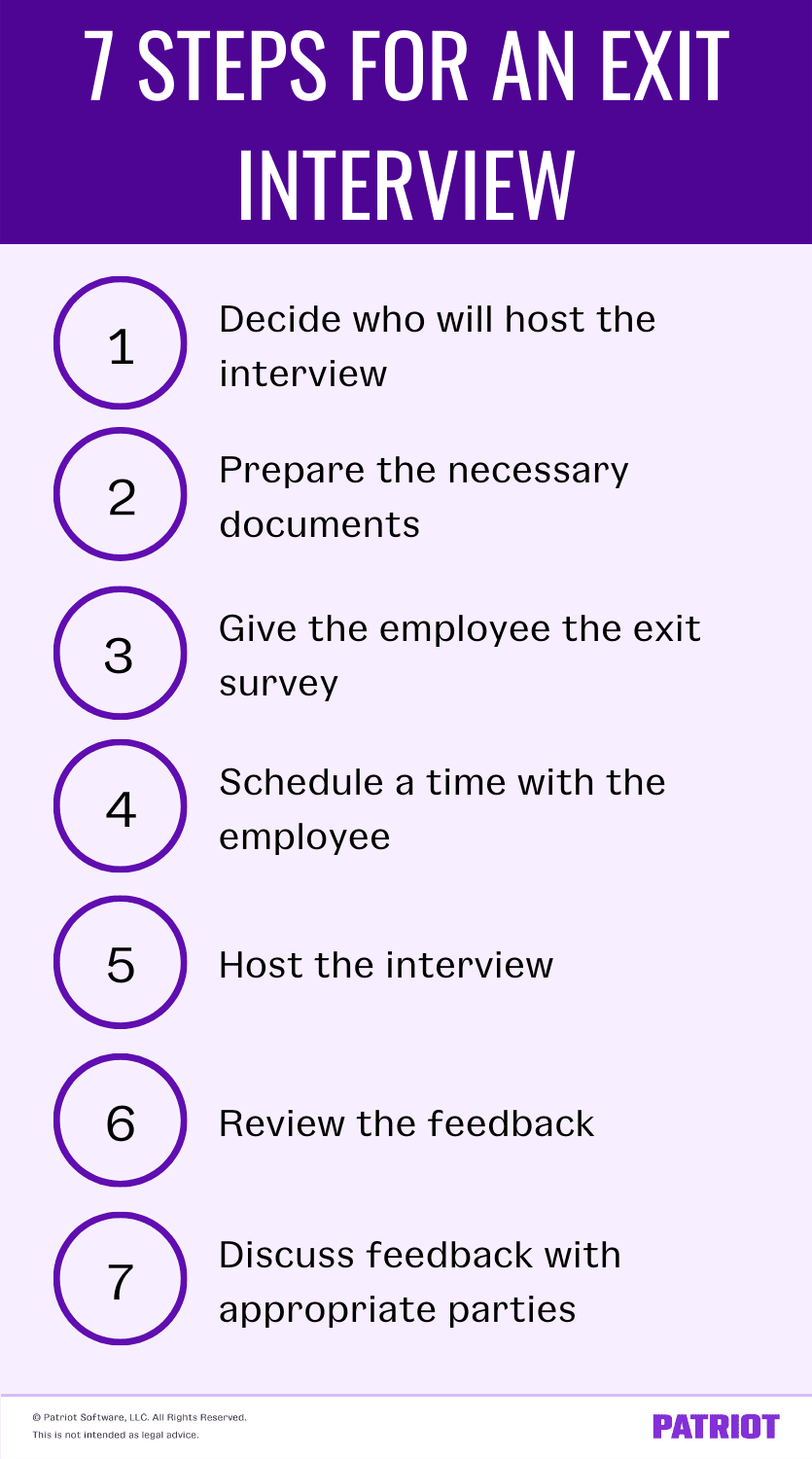One of the better parts of being an employer is welcoming a new employee to your business. But, on the flip side is the not-so-fun part of watching or letting an employee go. And when key players choose to leave, it may be in your best interest to hold an exit interview. But, what is an exit interview, and why is it a good idea to have one?
The basics of an exit interview
So, what is an exit interview, exactly? The exit interview is a conversation between the employer and the exiting employee. The goal of the conversation is to ask the employee questions about the company, the employee’s supervisor, and the job the employee had.
Sometimes, the “conversation” is just some paperwork the employee fills out and returns. The exit interview is also known as the employee exit survey or an exit interview survey.
There are seven steps for exit interviews, including:
- Decide who will host the interview
- Prepare the necessary documents
- Give the employee the exit survey
- Schedule a time with the employee
- Host the interview
- Review the feedback
- Discuss feedback with the appropriate parties

1. Decide who will host the interview
Who conducts the exit interview is an important part of the process. As the employer, do you want to be present? Or, do you want to have the manager or supervisor oversee the exit interview? Another option is to have an impartial party, such as a representative from HR, sit down with the employee for the interview.
Ask yourself what the goal of the exit interview is. If you want an impartial review, consider having a member of HR sit in with the exiting employee. Do you want to send the message to the employee that there are no hard feelings? If so, you may want to sit down with the employee yourself or have the employee’s direct supervisor or manager hold the meeting.
2. Prepare the necessary documents
Before conducting an exit interview, get your paperwork ducks in a row. Some potential paperwork to gather includes:
- The employee’s final paycheck, depending on your state’s final paycheck laws
- A copy of the Consolidated Omnibus Budget Reconciliation Act (COBRA) Notice of Qualifying Event and the Election Form
- A copy of any signed agreements between the business and the employee (e.g., noncompete agreements)
- The employee exit survey
Carefully review any state laws regarding paperwork you need to distribute when an employee leaves your business. For example, some states require employers to distribute an employee’s final paycheck on the employee’s last day.
Remember that you may need to distribute a COBRA Notice of Qualifying Event when a worker’s employment is terminated, whether the termination is voluntary or not. You can give a copy during the exit interview or send it via email or mail to the employee.
Prepare the documents ahead of time to ensure that you have everything you need to give the employee before they leave.
3. Give the employee the exit survey
An exit survey is optional. But, you may choose to have the exiting employee complete a survey to learn additional feedback, like why the employee is leaving or how they felt about their role or the company.
You have a few options with the exit survey to consider:
- Ask different questions on the survey than you do in the interview
- Ask the same questions on the survey as you do in the interview
- Use the survey to determine if you want to have the exit interview
And, you may choose different ways of asking the questions:
- Multiple-choice with options for levels of agreement (e.g., Do Not Agree or Agree)
- Fill in the blank
- A combination of multiple-choice and fill in the blank
For example, you may write, “My role was adequately explained to me before my hire,” and allow the exiting employee to select that they do not agree, somewhat agree, or completely agree. Or, you may ask how the job description for the employee’s role could be improved and allow the employee to write out their answer.
You may even decide to skip a formal exit interview in lieu of a detailed exit survey.
4. Schedule a time with the employee
When an employee gives you notice of their intent to leave, they often have some strings to tie up. This can include clearing out their office, training someone to take over their responsibilities, or passing along projects to coworkers. While the employee completes their final tasks with your business, contact them to nail down a time for a final meeting.
Pick a time and a neutral, private location to sit down with the employee. Scheduling ahead of time lets the employee clear out their schedule to ensure they can focus entirely on the exit interview.
You may want to choose a time before the employee leaves. Or, you may wait until after the employee leaves. Determine what timing works best for you and the employee.
Can’t get enough small business news?
Get the latest small business news delivered straight to your inbox.
Subscribe to Email List5. Host the interview
The employee exit interview is an opportunity to receive feedback on the employee’s role, experience, and the company as a whole. So, exit interview questions may vary depending on the information you want to learn.
Examples of what to ask in an exit interview include:
- What led to your decision to leave the company?
- What is some feedback you would like to give regarding management?
- How can the company improve?
- Do you feel that you received adequate, beneficial training and development?
- Can you tell me about a time when you felt proud of your work?
- How accurately was your job explained to you before you were hired?
- Was the workload reasonable or unreasonable for your position, and why or why not?
Pay careful attention to the answers the employee gives. And, ask if you can share the feedback with the appropriate parties. After all, the exit interview should be a confidential meeting.
6. Review the feedback
After the exit interview, take time to sit and review the information the employee gave. Use the feedback to consider ways you can improve.
Did the employee identify work that was not included in the job description that you can add for future listings? How can you use the information to improve training for current employees? Was there specific feedback regarding management or the company’s culture? Ask yourself these types of questions to identify how your business can improve.
After reviewing the feedback (especially if you did not conduct the interview), it’s time for the final step…
7. Discuss feedback with the appropriate parties
When employees leave your business, you can share the employee’s feedback with management, if the employee gives permission. You can use the feedback to address any concerns the employee had regarding their supervision or management.
And, you may choose to discuss the feedback with your management team to create new practices or change up employee training.
Even if you do not discuss the specifics in the employee exit interview, you may discuss ways to build upon what you learned. For example, an employee may say that they felt they did not train frequently enough. So, you use that feedback to work with management to work in more training opportunities for employees.
This is not intended as legal advice; for more information, please click here.
